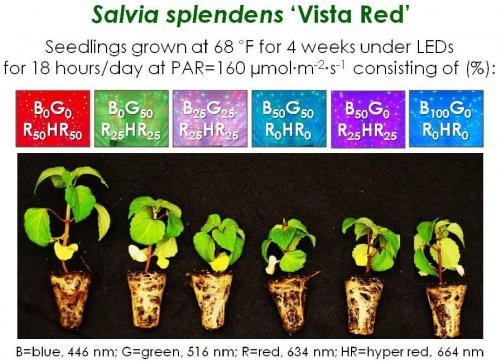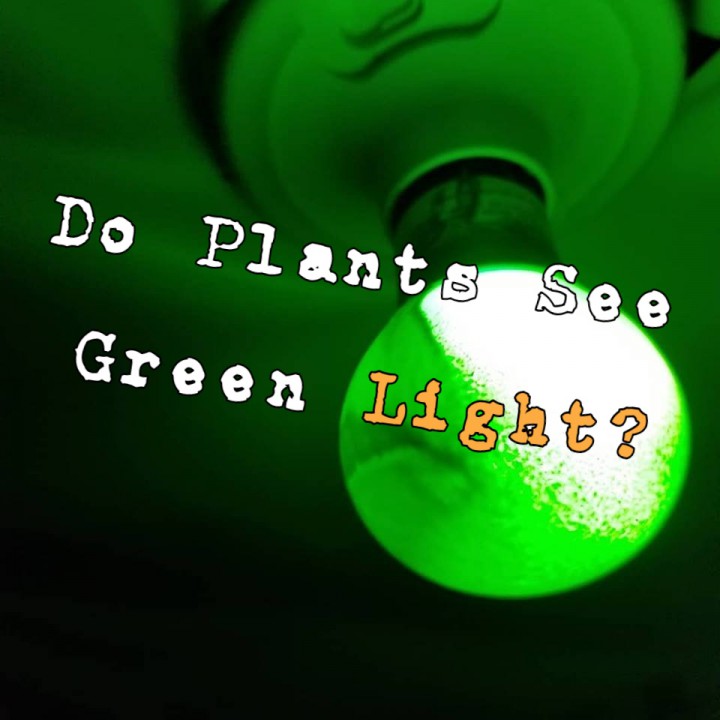Most growers focus on the importance of deep red or blue light in the photosynthetic process. These are doubtless the most important wavelengths to consider when deciding on a lighting solution for a grow. However, other wavelengths of light can also be important in any grow and deserve attention. They can affect yield and quality; for the better if used correctly, and for the worse if used incorrectly.
One type of light that is sometimes overlooked is green light. Some growers have stipulated that plants can’t “see” green light. This is slightly misleading. As we will explain further below, green

light can be made to have only small effects on plants when beneficial to the grower. However, plants do see green light and it plays an important role in growth. Plants can use light that falls on the spectral range between 400nm and 700nm. This is known as photosynthetically active radiation (PAR) light. Green light appears at a wavelengths between 520nm and 560nm. Looking at the above graph depicting the efficiency of various light wavelengths, it is easy to see that while still useful, green light is some of the least efficient types of light for photosynthesis. This is actually the reason for leaves’ green colour. They reflect more green light than any other colour.

.
This is not to say, however, that green light is not useful. In fact, the Michigan State University Department of Horticulture claims that, “[t]he majority of green light is useful in photosynthesis.” Approximately 85% of green light is absorbed by plants. One experiment showed that when paired with red light, green light was actually able to increase the growth of salvia plants compared to blue light. Further, leaf area index has been shown to increase with increased green light, especially at high light levels.
Studies in genetics have shown that green light affects plants, at least in part, because of their cryptochromes. Cryptochromes are responsible for a lot of a plant’s reaction to blue light. Green light, when used after blue light, has been shown in some instances to reverse the growing effects of blue light, especially in the stems of plants. And further, when used in conjunction with blue light, green light can hinder the ability for the plant to grow. That is the reason for the salvia plant above being grown under red, green and blue light, being smaller than the plant grown under only red and green light. It is important for growers to recognize that while green light can often be beneficial to a grow, using it in conjunction with blue light is often going to have negative effects.
Beyond the growing benefits from the inclusion or the increased use of green light there are also some practical reasons for preferring green light when growing. Green light has been shown to be less damaging and irritating to workers’ eyes. This would help alleviate workplace stress and other bodily harm that can come from prolonged exposure to light. Another advantage of green light is that they can be used during the scotoperiod (the dark period) to provide visibility to workers without having a significant impact on the plants. While green light does have an impact on plants growth, low intensity green light will only have a small impact on plants. So, if it is necessary for workers to have visibility to work during the scotoperiod, low intensity green light can be a great solution. Studies suggest that green light at night do not disrupt the scotoperiod and do not have a significant impact on yield when used for visibility.
.
Plants do see green light. Not only do they see it, they benefit from it in many ways. The importance of green light in aiding or hindering plant growth cannot be overlooked. It is also important to understand the advantages of green light beyond actual growth but in its helpfulness to workers who want to have more time with the plants. As research continues, our understanding of different light wavelengths will hopefully allow us to harness the benefit of green light and other light types, perhaps even to the extent that blue and red light are today.

